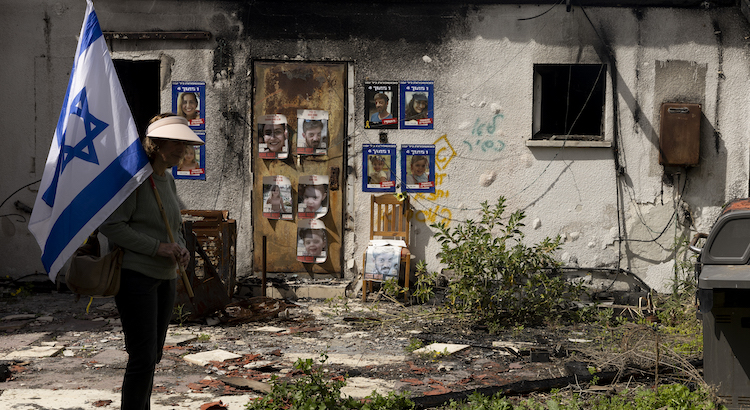Much of the first-person videography of the Oct. 7 massacre comes to us courtesy of the Hamas psychopaths who proudly recorded their actions that day. But footage from the phones of survivors of the attacks add a crucial dimension to our understanding of the atrocities. A new documentary, Saturday October 7, contains such scenes from survivors of the Nova music festival, where Hamas killed hundreds, and they are intense and terrifying and confusing in a radically different way from the videos many of us are used to seeing.
The hourlong film, which also mixes in Hamas GoPro footage, is a project of the Jerusalem Institute of Justice and features seven Israeli survivors of the attacks—five from the Nova festival and two from nearby kibbutzim, Nirim and Ein Hashlosha.
One of the Nova survivors, 33-year-old Mazal Tazazo, began recording on her cellphone as her group of friends exited the festival. At that moment, it was still unclear what was happening—the festival had ended abruptly as the area came under heavier-than-usual rocket fire from Gaza. The group gets into two separate cars and makes a plan to meet at Tazazo’s home because it’s the closest. “But then we hear shooting,” she says, and they started to understand getting home wouldn’t be easy.
They get out of their cars and Tazazo lets the recording continue but now, realizing they’re in danger, merely holds the phone in her hand as she moves about. We no longer see a “filming” of what she sees. Instead, we mostly see the ground as we hear the friends go through one terrifying moment after another—they see people running away from terrorists and coming their way, they hear gunfire get closer and closer, they crouch behind an Israeli police officer until they realize that one man with a handgun is no match for what’s coming.
They run behind cars, under cars, across the street, and then finally off the road to try to hide in the brush. Terrorists soon find them and order them to get off the ground. One hits Tazazo in the head with the butt of his rifle, hard enough to momentarily knock her out. When she regains consciousness, she can feel one of the Hamas men tying her legs together—presumably to take her hostage. One man picks up her face to see if she’s still alive, and drops it back on the ground; Tazazo was able to play dead long enough to convince them she really was. Tazazo assumes she is dying from her wounds and they didn’t want to carry her along if she wasn’t going to make it to Gaza. She passes out again. When she wakes, she realizes her friends were on the ground with her—they were dead.
That wasn’t the end of her ordeal, however. The terrorists set fire to the bushes on the sides of the road to smoke out—or burn alive—anyone who had survived. Tazazo eventually saw an opening and made a run for a nearby car and laid down until help finally arrived.
In another scene, this one filmed by a Hamas GoPro, we see terrorists going through a house looking for Israelis to kill. One gunman brushes past a safe-room entrance (it’s hard to tell from the video if it’s a false wall or a door), looks at it, and moves on. An on-screen graphic tells us there were civilians hiding in that room at the time. Eventually the terrorists move on. I found myself repeatedly holding my breath.
Another survivor tells her story interspersed with the audio of her phone calls with her father as she hid in a bomb shelter among dead bodies. Every so often a group of terrorists would come looking for survivors, the anxiety so taxing that eventually she falls asleep among the bodies. Unlike most of those around her, she wakes up.
Stories like these make clear just how much all the survivors had been through.
One of the survivors explains what her nights are like: “Total lack of sleep. Until you manage to fall asleep and then wake up in the middle of the night [from] terrible nightmares that are always accompanied by weapons or shouting.”
Tazazo describes living like a zombie, the terrorists having “crushed” the person she was. Another survivor had to leave his job as a chef because the intensity of a restaurant kitchen was overwhelming after what he’d been through.
Another explains how hard it is to recover from the trauma because of the cruel reaction of so much of the world: “I think all the time how much easier and better it would be for us if we could just focus on recovery…. It’s not logical that this is our job, it’s not logical that we need to go every day—every day—to interviews, dialogues, and meetings to convince people that this happened at all.”
The trailer and information on screenings can be found at saturdayoct7.com.


















